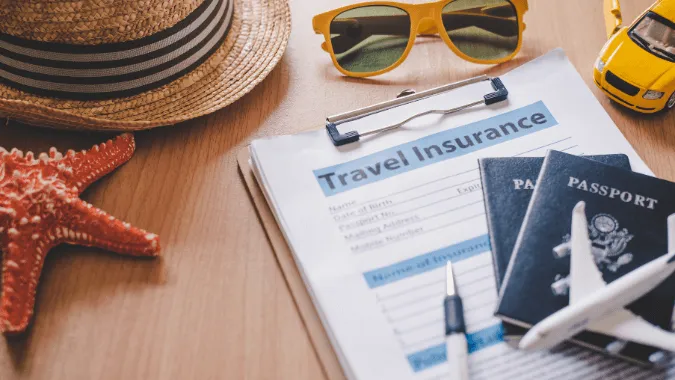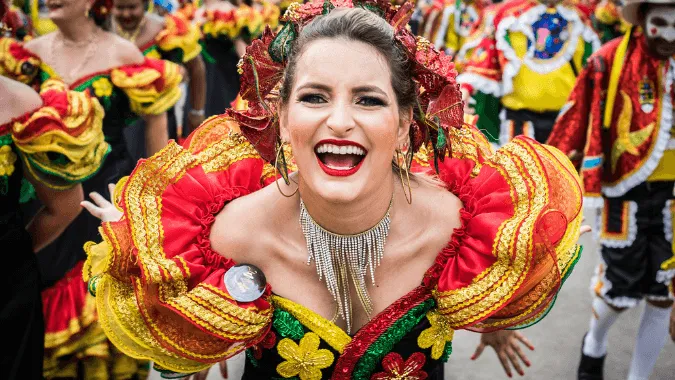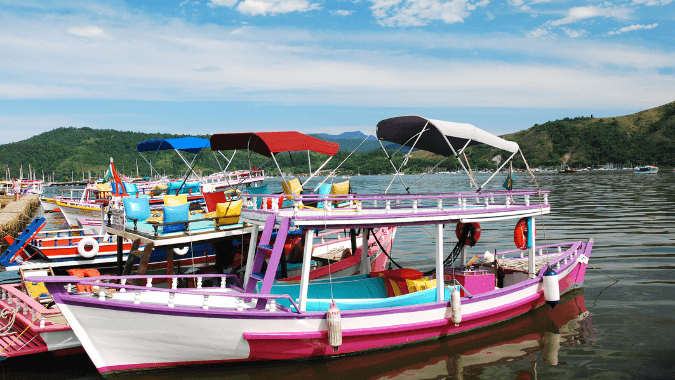Useful Facts About Uruguay
Spanish is the official language of Uruguay. It is most similar in sound to Argentine Spanish thanks to the same Italian influences. Like the Spanish spoken in Buenos Aires on the other side of the Rio de la Plata, the dialect of Spanish in Uruguay is called Rioplatanese. One of the characteristics of this dialect of Spanish is the use of “vos” instead of “tu.” Another word you’ll hear a lot in Uruguay is “ta,” which means OK.
The other informal language spoken commonly in Uruguay on the border with Brazil is Portuñol, a mix of Spanish and Portuguese. The specific Riverense Portuñol spoken on the Frontera de la Paz (referring to the section of the border covering the sister towns of Uruguay’s Rivera and Santana do Livramento) is closer to Portuguese, with Spanish influences.
2. WEATHER

Uruguay's climate has different seasons, but without drastic variations. It is usually humid subtropical / Photo: Canva Pro
Uruguay’s climate is humid subtropical. Located in the temperate zone of the Southern Hemisphere, Uruguay’s weather has distinct seasons but without massive
In the summer, the average high is 28°C (82.4 °F) with a low of 17°C (62.6 °F). The summer is characterised by the warm Zonda winds blowing in from the north.
In winter, the average is temperature ranges between 6° and 14 °C (57.2 and 42.8 °F). Cold pampero winds blowing in from the pampas bring cold and dry conditions.
Because there are no mountains, the winds tend to blow very strongly through the country, with rapidly changing weather and storms and fronts moving quickly over. There is no real rainy season; rainfall is fairly steady all year round, with moderate rainfalls.
3. TIME
Uruguay is in the UTC / GMT -3 timezone. The country observes daylight savings, beginning the first Sunday in October and ending the second week of March. The longest day of the year is 14:20 hours, and the shortest is 9:39 hours.4. WORKING HOURS
Business hours are typically from 9am to 5pm, Monday to Friday. A midday siesta is still a common tradition, although tourist areas and busy commercial centres do stay open. Likewise, during high season in places like Punta del Este and other coastal cities, restaurants and big stores will stay open. Retail outlets typically stay open until 6:30 or 7pm, and open for a half-day on Saturdays.5. RELIGION
Uruguay is a secular country with no official religion and complete religious freedom. The dominant religion is Catholicism, with 47% of the population identifying as Catholic. A further 40% of the population identifies as non-religious.Uruguay’s secularism is often cited as the reason for its liberal laws, especially in comparison to many other Latin American countries. Uruguay was the second region in Latin America to legalise same-sex marriage, and is welcoming to all travellers. Uruguay has also legalised abortion and the production and sale of marijuana.
6. BANKS MONEY EXCHANGE
To exchange money in Uruguay, go to an exchange bureaux or a bank. Avoid changing money in the airport, where the rates are the worst. BROU is the national bank. No commission is charged, and there isn’t a big discrepancy between the rate at banks and exchange bureaus. Banks are only open in the afternoon from 1 to 6pm. It is possible to withdraw dollars at ATMs around the country. Depending on the bank, there is a US$300 limit for withdrawals, but you can make multiple transactions in one day. Be aware that on weekends there tend to be queues for the ATMs, particularly in Colonia, with Argentines and expats in Argentina looking to get out dollars.7. CURRENCY
The currency is the Uruguayan peso, which is indicated by the $ symbol (US dollars are marked as US$). Banknote denominations are 50, 100, 500 and 1,000; while coins come in denominations of 1, 2, 5 and 10. It is always good to have change as many places won’t accept larger denominations.
The exchange rate is roughly 1 dollar = 44 uruguayan pesos. Check the exact current exchange rate here. While it is easy to exchange money, particularly US dollars, euros, Brazilian reales and Argentine pesos, many places accept foreign currency, especially dollars and Argentine pesos. Colonia is particularly receptive of foreign currency because of the high number of day trippers from Buenos Aires.8. VISAS
The only countries that require a visa are Russia, Morocco, India, Guyana, Egypt, Armenia and Albany. There is no reciprocity fee. You just need to have a valid passport. Bordering countries, Argentina, Brazil and Paraguay, citizens only need to show their national ID document.9. TAX FREE SHOPPING
Foreigners are given refunds on VAT in Uruguay. Purchases must be made with a foreign-issued debit or credit card to qualify for the refund. This can be claimed at border crossings, including airports and ports and land crossings.10. AIRPORTS

Carrasco International Airport has been chosen as one of the 22 most beautiful airports in the world by the famous British newspaper HuffPost / Photo: Canva Pro
Carrasco International Airport in Montevideo is the country’s largest airport. Airlines that fly here include American Airlines, Air France, Iberia, LAN, TAM, Aerolineas Argentinas and Avianca.
A new national carrier, Alas Uruguay, is replacing the defunct PLUNA (the previous National Carrier) and will be opening up flights from Montevideo to Asuncion, Buenos Aires, Santiago, Sao Paulo and Rio de Janeiro.
11. TRANSPORTATION
Uruguay has a well-established public transport system. Taxis and remises (radio taxis that you call) can be found in all cities. Montevideo has a good city bus system. In addition there are minibuses that run between towns as well as long distance buses that go across the country as well as to Argentina, Brazil and Paraguay. The main bus station in Montevideo is the Tres Cruces Bus Station. Bus routes and prices for bus travel in Uruguay can be found on Omnilineas. There are a number of domestic airports for internal flights, but due to Uruguay’s small size, it is usually easiest to take the bus or to rent a car. Most nationalities need just their driver’s license, passport and credit card. Other nationalities may require an international driver’s license. Citizens of the americas will need to get the IADP (Inter-American Driving Permit). Keep in mind that Uruguay has the highest gas prices in Latin America.12. PHONES & CODES
There are numerous public phones in Uruguay. These use prepaid cards which can be bought at Antel offices (the country’s telephone company), or at newspaper kiosks. Cards are valued at 20, 50, 100, 200 and 500 pesos. It is easy to buy a local SIM card for cellphones. These can be found at most kiosks. There are three companies to choose from: Antel, Movistar and Claro.To dial a number in Uruguay, use +598 followed by the area code. To reach Montevideo, dial +598-2, and to dial a number in Punta del Este, insert +598-42.
There are many internet cafes scattered around all major cities. In addition, there is free wifi available in most restaurants, cafés, hotels and on public buses. Uruguay has some of the fastest and cheapest access to internet in Latin America.
13. ELECTRICITY
Electricity in Uruguay runs on 220-240V, 50Hz. Bring a transformer if necessary for electrical appliances. The power sockets and plug types used are C, F, I, L. Typically these are two round pins, or V-shaped flat prongs. Check whether you need an adaptor before travelling.
14. HEALTH
There are no major disease risks in Uruguay. No vaccinations are necessary to travel here. The drinking water is considered safe in the country’s cities.One precaution that tourists in Uruguay should take is a high SPF sunscreen. There is a hole over the ozone layer above Uruguay, and this has resulted in a high rate of skin cancer. If you’re spending time outdoors, particularly in the summer, make sure you always protect yourself with sunscreen.
Medical treatment is not cheap in Uruguay, so it is recommended that all travellers obtain travel insurance that covers medical emergencies. There are both public and private hospitals. At a private hospital you will need a valid travel insurance policy or proof of funds before you are treated.
In case of a medical emergency, dial 105 for an ambulance and 911 for general emergencies. List of hospitals in Uruguay.15. SAFETY
Uruguay is considered one of the safest countries in South America. Most crime can be found in Montevideo, the capital city. Montevideo’s old city is not the safest area at night, and is best avoided. Take the same precautions you would in any big city. Most crime is opportunistic street crime. There is little violent crime in Uruguay.
Should you run into any trouble, you can contact the Tourist Police of Montevideo on their free number: 0800 8226
16. CUISINE

The chivito is one of the few dishes whose origin can be attributed exclusively to Uruguayan gastronomy / Photo: Canva Pro
Food in Uruguay is heavily influenced by the country's European roots. You will find a wide range of pastas, pizza and sausages. However, the great emperor of Uruguayan cuisine is meat. With an average annual consumption of 3 cows per person, Uruguayan meat is considered one of the best in the world. The most common way to eat meat is the asado, where several types of cuts are available, accompanied with black pudding and sweet bread. Another way to enjoy a good steak is inside a chivito - a type of sandwich with meat, ham, cheese, egg and mayonnaise. Among the desserts, dulce de leche, a kind of caramel, is as popular as in Argentina. In addition, there is the flan and the chaja - a spongy cake covered with cream and pieces of meringue. The quintessence of drinks in Uruguay is mate, a kind of infusion made with yerba leaves, served in a totuma or pumpkin container. Wherever you go around the country, you'll see a Uruguayan with his mate, ready to drink, whether in the car, on the street or behind a desk. In terms of alcoholic beverages, Uruguay produces excellent wines and is known for producing Tannat wines. Another typical drink is grappamiel, made from grappa mixed with honey. Medium and medium, is a combination that carries half white wine and half champagne. Uruguay is also one of the largest consumers of whiskey per capita in the world. A typical scene that can be appreciated in Montevideo, is composed of groups of older people gathered in the bars of the Old City around 5pm to drink a glass of whiskey.17. PEOPLE
Uruguayans are warm and friendly people. They typically kiss on the right cheek as a greeting. Like many Latin American cultures, punctuality is not important. They tend to dress conservatively.
Uruguay is one of the most homogenous populations in Latin America. Almost 90% of the population has European descent, with the majority from Spain and Italy. A small percentage of the population is made up of mestizos (European-Amerindians) Amerindians and African descendants.There is a big emphasis on education in Uruguay. With a 98% literacy rate and a growing middle class, the country boasts lower inequality than most other South American countries.
Travel Tip: We will take you to know the most emblematic cities, Montevideo and Colonia del Sacramento, don't miss it, book your experiences in Uruguay with Daytours4u!
By: Daytours4u Contents Team.



